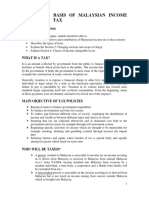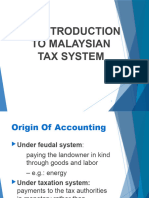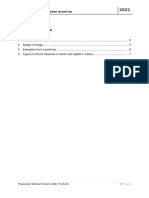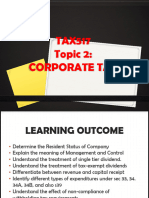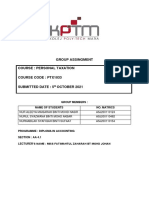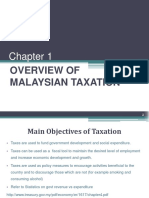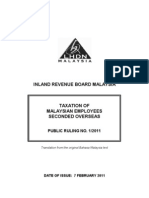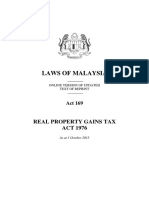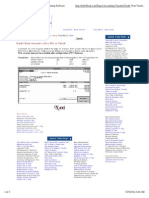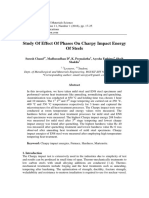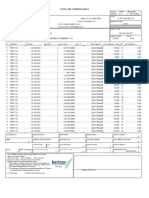INTERMEDIATE LEVEL
PERSONAL TAXATION
OBJECTIVES:
1. To examine the understanding of the basic concepts and principles of taxation.
2. To examine the application of taxation principles for the computation of tax on income derived
from Employment and other income. Section 4(b) to 4(f) of the Income Tax Act, 1967 (“the
Act”).
3. To examine the tax administrative aspects involving sole proprietor or partners in a partnership.
Note: Tax computation involving business income and adjustments for non-deductible items are
not tested in this paper.
CONTENTS:
(A) Scope Of Charge and Basis of Taxation
1. Understanding the taxation system in Malaysia
2. Scope of charge (Section 3 of the Act)
3. Classes of income chargeable to tax (Section 4 of the Act)
4. Exemptions applicable to individuals (Schedule 6 of the Act)
5. Chargeable persons (Section 2 of the Act)
(B) Residence of Individuals (Section 7 of the Act)
1. Determination of residence status
2. Significance of residence status
(C) Employment Income [Section 4(b) & Paragraph 13(1) of the Act]
1. Meaning of employment
2. Distinction between contract of service and contract for services
3. Gains or profits from employment
4. Derivation of employment income
5. Valuation of benefits-in-kind
6. Deductible expenses
7. Compensation for loss of office
8. Gratuities, Golden handshakes
9. Share options, incentive schemes and profit sharing schemes
10. Exemptions specifically applicable to employment income (Schedule 6 Paragraph 21 of
the Act)
(D) Other Sources of Income [Section 4(c) to Section 4(f) of the Act]
1. Dividends
2. Interest
3. Discounts
4. Rents
5. Royalties
6. Premiums
7. Pensions
8. Periodical payments
9. Annuities
10. Single-tier dividends
11. Distribution of income from Unit trust
12. Distribution of income from REIT
13. Derivation of other sources of income
� 14. Deductible expenses
15. Non-deductible expenses
16. Other gains or profits
(E) Personal Reliefs and Rebates (Section 46 to Section 49 & Section 6 of the Act)
(F) Computation of Tax Liability (Section 38 to Section 45 of the Act)
1. Taxation of individuals
2. Taxation of husband and wife
3. Determination of employment income and income from other sources
4. Computation of adjusted income, statutory income, aggregate income, total income,
chargeable income, tax chargeable and tax payable from sole-proprietorship or
partnership
5. Separate assessment and joint assessment
(G) Tax Administration
1. Organizational structure of the Ministry of Finance, Inland Revenue Board of Malaysia
and the Royal Malaysian Customs Department
2. Duties and powers of the Director General of Inland Revenue Board of Malaysia
3. Returns and Assessments including deadlines for submission and payments
4. Monthly deduction and final tax
5. Collection and recovery (Section 103 of the Act)
6. Appeals process
7. Administrative aspects of non-resident and of residents i.e. employees and business
owners
8. Compensation for late refund
9. Tax estimates, tax installments and underestimation of tax for sources other than
employment income
10. Powers of the Director General of Inland Revenue Board of Malaysia to restrict persons
leaving Malaysia
11. Key deadlines for submission of the return forms and payment
12. Penalties for late submission or late payment of outstanding tax
13. Offences and other penalties
14. Responsibilities to notify of chargeability to tax
READING LIST - PERSONAL TAXATION
1. Income Tax Act 1967. (as amended)
2. Public Rulings and Operational Guidelines.
3. Jeremy French. Malaysian Taxation. (Latest edition)
4. Choong Kwai Fatt. Malaysian Taxation Principles & Practice. (Latest edition)
5. Veerinderjeet Singh. Veerinder on Malaysian Tax Theory and Practice. (Latest edition)
6. Jeyapalan Kasipillai. A Guide to Malaysian Taxation. (Latest edition)
7. Tax Guardian, Journal of the Chartered Tax Institute of Malaysia


















